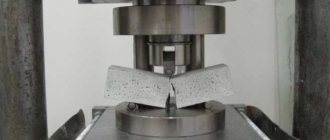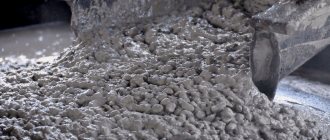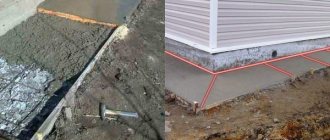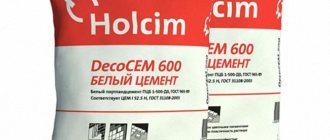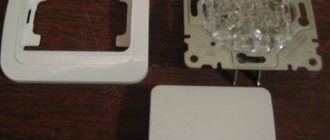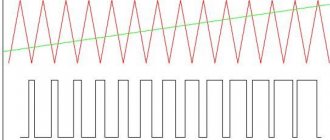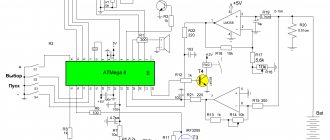Beton-House.com
Website about concrete: construction, characteristics, design. We combine the experience of professionals and private craftsmen in one place
Structure of heavy concrete of the test sample
The design compressive strength of concrete is one of the key characteristics that must be taken into account when designing any structure made from this material, and at the beginning of any construction. At the same time, it is necessary to pay attention to it not only to professionals, but also to ordinary craftsmen who have decided to build a house with their own hands.
- What determines the strength of concrete?
Definitions
Strength is the main quality that accurately describes its load-bearing capacity. It is determined by the compression limit - this is the highest load limit at which failure of the sample occurs. And this is the main indicator that is taken into account when using it.
Design resistance is an indicator of a material’s resistance to loading influences. It is used in design calculations, and is integrally related to standard indicators of compression resistance.
Until the 2000s, they focused only on grades of material, which were taken as a design indicator, but according to new technical documents, each grade was assigned a new criterion for the sample’s compliance with compressive loads.
It was identified in laboratory conditions, legalized by specialists and reflected in SP 52−101−2003. According to this technical document, the standard resistance of a material to axial compression is the compression class specified with 95% certainty. The condition means that it is met in 95% of tested cases, and only in 5% can it deviate from the established indicators.
But even this percentage proves that using average calculated indicators when designing is unjustifiably risky. And when choosing the smallest value, the cross-section of the structure or product will increase, which in turn will affect the overexpenditure of money and energy resources.
According to SP 52−101−2003, standard resistance values are presented in the photo below.
Standard and calculated resistance values
There is also such a definition as tensile strength. By its nature, this material can withstand tensile loads much worse. That’s why it is reinforced in reinforced concrete products, thick floor screeds, foundations, etc.
When calculating, the compression indicator is used as a priority. In principle, any product or structure experiences heavy loads precisely from compressive static or dynamic influences. But resistance to bending influences is taken into account during design. In such cases, simply use the class correspondence table.
Table 6.7 from SP 63.13330.2012 SNiP 52-01-2003, which indicates the grades of resistance to compression and tension.
| View | Concrete | Standard resistances MPa, and calculated resistances for limit states of the second group and MPa, with a material class according to compressive strength | |||||||||||||||||||||
| B1.5 | AT 2 | B2.5 | B3.5 | AT 5 | B7.5 | AT 10 | B12.5 | B15 | IN 20 | B25 | B30 | B35 | B40 | B45 | B50 | B55 | B60 | B70 | B80 | B90 | B100 | ||
| Compression axial tension | Heavy, fine-grained and straining | — | — | — | 2,7 | 3,5 | 5,5 | 7,5 | 9,5 | 11 | 15 | 18,5 | 22 | 25,5 | 29 | 32 | 36 | 39,5 | 43 | 50 | 57 | 64 | 71 |
| Easy | — | — | 1,9 | 2,7 | 3,5 | 5,5 | 7,5 | 9,5 | 11 | 15 | 18,5 | 22 | 25,5 | 29 | — | — | — | — | — | — | — | — | |
| Cellular | 1,4 | 1,9 | 2,4 | 3,3 | 4,6 | 6,9 | 9,0 | 10,5 | 11,5 | — | — | — | — | — | — | — | — | — | — | — | — | — | |
| Axial tension | Heavy, fine-grained and straining | — | — | — | 0,39 | 0,55 | 0,70 | 0,85 | 1,00 | 1,10 | 1,35 | 1,55 | 1,75 | 1,95 | 2,10 | 2,25 | 2,45 | 2,60 | 2,75 | 3,00 | 3,30 | 3,60 | 3,80 |
| Easy | — | — | 0,29 | 0,39 | 0,55 | 0,70 | 0,85 | 1,00 | 1,10 | 1,35 | 1,55 | 1,75 | 1,95 | 2,10 | — | — | — | — | — | — | — | — | |
| Cellular | 0,22 | 0,26 | 0,31 | 0,41 | 0,55 | 0,63 | 0,89 | 1,00 | 1,05 | — | — | — | — | — | — | — | — | — | — | — | — | ||
The shear strength during chipping determines the resistance to compression and correlation indicators.
Note. Compression resistance B25 is the most commonly used indicator when designing a material.
Compliance of concrete grade with class
A certain class of concrete in terms of compressive strength has its own corresponding grade. In practice, a table of this ratio was compiled. For example, according to the table, the M50 brand corresponds to class B3.5.
The coefficient for converting the concrete class to the corresponding grade is 13.1.
Most often in construction, the term “class” is used to determine strength. Unlike brands, this parameter calculates the guaranteed strength of the material.
Return to contents
Axial compression. Calculations and values
When making calculations, it must be taken into account that class (B) directly depends on its average strength R, MPa. Accordingly, the following formula is used:
B = R (1−tV), where t is the security class included in the design, generally take the value 0.95, respectively t = 1.64; V – strength variation coefficient. 1 – constant.
If the standard coefficient V = 13.5% (0.135) was used in the calculations, then the average strength is equal to R = B/0.778.
It’s another matter when all kinds of reinforced concrete structures are calculated. The boundary height of the specified zone is calculated especially carefully. It expresses the height at which, before failure, the stresses in the compressed material and the tensile reinforcement reach their maximum values simultaneously. Only under this condition can the section be considered normally reinforced.
According to SNiP 2.03.01 - 84, the height of the zone is the formula:
Compressed zone height formula
In this case, the relative height of this zone (table) is used for a specific product. They can be found in regulatory documents, and the data can be used in calculations. Basically, the information provided briefly explained what the compression zone and axial compression resistance are.
Methods for determining strength using control concrete samples
Having understood what the compressive strength of a material is, we will consider the main methods for determining this indicator.
Destructive testing of concrete
Compression testing is usually carried out in accredited construction laboratories using certified equipment. The main thing you need for it is a press.
Accurate laboratory scales, calipers and test specimens will also be required. The latter are prepared in advance from the required batch. The shape is standard - a cube with sides of 10 cm. According to technical documents, from 3 to 5 samples are used for one batch.
Advice. Initially, they need to be prepared by cleaning them from contamination and weighed to determine compliance with the density, weight and design grade of the material. If these values are normal, then you can be 95% sure of the proper level of stability.
The sample is placed on the press with absolutely even edges, turned on and testing begins. The maximum load at which the sample began to fail is the ultimate compression.
The average value is established based on the results of control of all selected samples. The final figure determines whether or not the actual strength corresponds to the standard and design values. After which it is entered into the journal.
Gallery: destructive testing process using a press.
More detailed instructions for testing concrete samples are presented in the video in this article.Non-destructive testing
The previous method is required in any construction industry and at any stage of construction.
It is considered the most reliable:
- Designers and architects rely on the results of laboratory destructive research protocols when constructing buildings and manufacturing reinforced concrete products.
- When it is not possible to determine the strength of samples using a destructive method, or when repeated analysis of the characteristics is required after a certain time, special devices are used.
- They are necessary in order to test the material for compression directly on site. With one light touch they determine the numerical value and, if desired, other necessary characteristics regarding the uniformity and compaction of the material body.
- There is a lot of similar equipment, but the most common in construction circles is the IPS - MG device of various modifications. It is easy to use, accurate and affordable.
Photo of an automated device.
It is mainly used on construction sites. This electronic meter allows you to quickly determine density, strength and elastic-plastic properties using the shock pulse method. Although this method is not a priority, it is still provided for by GOST 22690.
Advice. Before “shooting” the concrete, it is imperative to select or prepare the surface. It must be smooth without roughness, dents, voids, cracks and other defects with an area of at least 100 cm2. If necessary, you need to sand the surface.
The number of sections must be accepted according to the test program, but there must be at least three. Typically, for a volumetric reinforced concrete structure, an average value of 15 samples is taken.
This amount depends on the area, since the control points must be at a distance of 15 mm from each other and at least 50 mm from the edge. Ideal places are between crushed stone granules and large shells in the concrete body.
To test the design, you must:
- turn on the device, and it will immediately be in test mode;
- enter data about the material being tested;
- cock the lever on the “pistol”;
- press firmly perpendicular to the surface being tested and release the lever;
- the result will appear on the scoreboard, it will be remembered for subsequent tests;
- after 15 samples, the average value is automatically displayed; if the number of “shots” is less, then you can view the average result in advance.
What’s good about such a device is that all the data on it can be saved on a computer and archived. You can review previous tests on your computer at any time and create a report.
Other characteristics of concrete
Compressive strength is not an independent characteristic. It, like others, depends on many circumstances and other properties of the material.
What determines the strength of concrete?
Main factors:
- quality of components, namely, activity and strength of cement, cleanliness and correct choice of aggregate size modulus, chemical composition of water, correct selection of plasticizing additives;
Components of heavy concrete
- optimal selection of composition that meets the main motto of reinforced concrete technologists: “maximum quality at minimum cost”;
- body-humidity regime of product processing;
- accuracy of testing samples in the laboratory;
- correct algorithm for stress relief of concrete products;
- subsequent aging of products under certain conditions.
Cracks are a sign of low-quality concrete
If, when measuring strength, the compression grade actually turns out to be much lower than the standard, be sure to reconsider the quality of the product according to the above points in order to identify the cause of the defect.
The essence and general characteristics of the concrete class
In a narrow sense, concrete mixture classes determine the load that one unit of surface area can withstand in the absence of damage. Units of measurement have been established over the years. At the moment, class indicators are determined in MPa.
The method for determining the strength of a solution is the same for both its class and brand. When tested, they are used in special laboratories, through experiments with samples of materials. Using special devices, work is done to establish the maximum force on the sample at which its destruction begins. Based on the data obtained, force is equal to pressure.
To achieve correct results, it is necessary to take into account the relationship between the load vector and the axis of the sample. For this purpose, the lower sides of the surface of the press and concrete are marked with axes that must coincide. According to GOSTs, there are 18 types of concrete mortar, depending on the compressive strength. For example, concrete B35. This designation means its strength at a pressure of 35 MPa.
Return to contents

